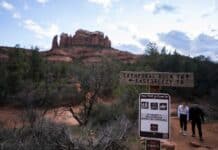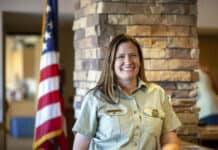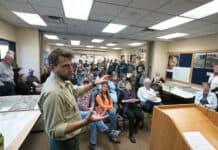This is the second part of a four-part story on the recent meeting of the Yavapai Cattle Growers’ Association.
Multiple panelists at the Yavapai Cattle Growers’ Association’s Sept. 7 meeting in Cottonwood described the U.S. Forest Service’s insufficient staffing levels as creating problems for proper rangeland management.
U.S. Rep. Paul Gosar [R-District 9] proposed solving these problems by selling off federal public lands.
University of Arizona range management specialist George Ruyle said that even with increases in staffing, there are not enough range monitors to cover the Prescott National Forest.
“I suspect that every district on the Prescott [National Forest] could use one more range conservationist,” Ruyle said. “That remains to be seen, of course, but more time, more people, more money is always needed in rangeland monitoring.”
Staffing issues also extend to archaeological monitors within the Prescott National Forest, Chino Winds Natural Resource Conservation District Chairman Gail Steiger explained in a previous interview.
“There was a big bottleneck [in rangeland improvements] because we’d have a lot of money available to do projects on the forest,” Steiger said. “But we had problems getting the projects through because the Forest [Service] didn’t have enough people to do the [archaeology] studies to make sure there weren’t any archaeological sites that would be damaged with any projects that we were doing. And we hired some archaeologists to help with that monitoring. They [the Forest Service] have a lot of unfilled positions and they just haven’t been able to do enough of the actual monitoring”
U.S. Forest Service Chief Randy Moore said that staffing levels have been a national challenge.
“Over the last 20 years, as the fire program has increased, all the natural research programs have gone down,” Moore said, discussing his priorities since assuming the position in June 2021. “In fact, over the last 20 years, we’ve lost about 38% of our non-fire workforce. The majority of those were natural resource-type positions. I had committed to hiring half of those back, and then matching the other half through partnerships.”
Moore cited a lack of young people studying rangeland management at universities and the GS-5 pay scale of many of those positions, which, “depending on where you are, is barely minimum wage,” as contributing factors to the service’s staffing problems.
“Last year, we hired about 3,400 people total,” Moore said. “But we lost 2,600 through attrition, so out of all of that hiring we did, we only netted about 800. That 800, though, are positions that are going into the ground-type positions. Range [conservationists] are one of the ones that we’re trying to fill.”
Arizona Sen. Ken Bennett [R-District 1], who represents Sedona and the Verde Valley, suggested including the Forest Service in the state’s career and technical education programs to funnel K-12 students into the agency.
Center for Biological Diversity Southwest Director Taylor McKinnon explained that rangeland monitoring understaffing across the 17.5 million acres on which the Forest Services administers livestock grazing affects both the finances of ranchers as well as threatened and endangered species.
“The [staffing] gaps include a lack of consistent monitoring across the board and, specifically, monitoring of livestock grazing impacts to imperiled species and the habitat conditions that [those species] need to survive,” McKinnon said. “They look at a narrow set of attributes that do not necessarily inform whether and the extent to which livestock grazing is impacting the most vulnerable species.”
“Climate change will require us to monitor more frequently and make management adjustments more frequently as we experience variations in weather patterns,” said Anthony Madrid, USFS deputy director of Wildlife, Fish, Rare Plants and Rangelands for the Southwestern Region.
“We have received a lot of interest from permittees on other national forests in Arizona,” Madrid added. “We will be following up to determine if we can expand this collaborative monitoring across the state.”
“There’s creative solutions already out there,” Gosar said. “U.S. Sen. Harry Reid had a program and it was basically the [Bureau of Land Management], because what ended up happening is Las Vegas was landlocked by [the] BLM, you couldn’t enlarge Las Vegas. So [Reid] came up with the Southern Nevada Land Exchange Program, that allowed those lands to be auctioned off, and the proceeds came back to the local areas. That generates a lot of money.”
Gosar stated that he used Reid’s program as a model for the Hunting, Education and Recreational Development legislation that he introduced in the House of Representatives on July 14, 2016, which did not make it out of committee. He argued that the act would have established “an orderly process for the sale, conveyance and exchange of federal lands not being utilized by public land management agencies that have been identified for disposal.”
Event moderator and former YCGA President Andy Groseta voiced his support for Gosar’s position of selling federal lands, calling it “a new source of revenue” for the USFS and other government agencies. He was among the supporters of the proposed legislation listed in Gosar’s 2016 press release announcing the introduction of the HEARD Act.
“I would be amiss if I didn’t say that we need to look at something that’s more permanent and it’s not government-driven,” Gosar said. “We’re $31 trillion in debt.”
Gosar said that when he and U.S. Rep. Eli Crane [R-District 2] go back to Washington, “we’re going to have to make some serious cuts. This is not sustainable, and so when you start looking at the development of the 10th Amendment, states’ rights, working with these federal partners, that’s why some of these other aspects like the HEARD Act and others may be … positive for you to look at.”






















